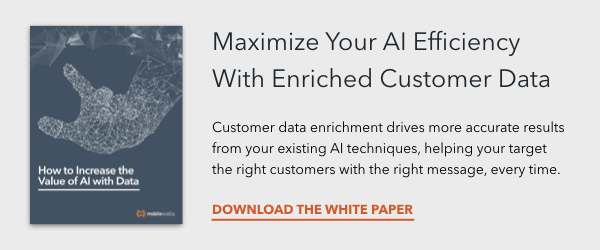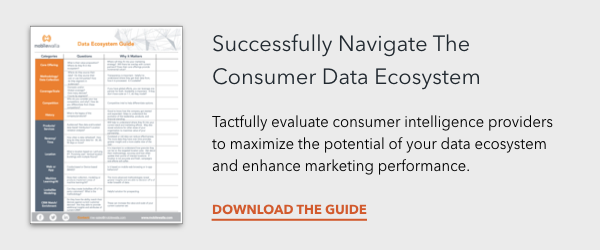To evaluate a data set’s inherent strengths and weaknesses, you must consider its source. Not all data is created equal and driving real results with AI and machine learning requires the right mix of owned and licensed data.
Data scientists and marketers classify data into three different categories – first-party, second-party, or third-party data – depending on its origin. To stay competitive with your data strategy, it’s crucial to understand the strengths and weaknesses of each category and how they work together.
What is First-Party Data?
In plain language, first-party data is information you collect from your audience yourself. It might include data gathered through form submissions, a CRM system, website cookies, a customer service center, purchase history or any other engagement you control, either online or offline.
92% of leading marketers believe using first-party data to continuously build an understanding of what people want is critical to growth.1 Here are some of the reasons why this outlook on first-party data is nearly unanimous:
- You own it. Any data you collect yourself represents a competitive advantage. Well maintained first-party data is an easily accessible and cost-effective exclusive asset.
- It offers a view into your buyers’ journey that’s insightful and can be predictive.
- It’s relevant and accurate because it’s gathered directly from your customers.
That being said, the exclusive use of first-party data leaves a glaring hole in what you know about your customer. After all, it’s limited to your customers’ direct relationship with you and what you’re able to record. It doesn’t capture anonymous browsing behaviors, other brand preferences, or competitor affinity.
And that lack of additional insight and scale can have a negative impact on your business. Without the proper breadth and depth of data, you can’t effectively power the predictive AI and machine learning algorithms needed to stay competitive and drive insights that deliver future ROI and business growth.
What is Second-Party Data?
Second-party data is first-party data that is collected by another organization. It can boost your overall audience insights, but only when derived from a business or brand with an audience that complements your own.
Because of its narrow scope, it shares many limitations of first-party data, including lack of scale. Second-party data also has limited availability because exchanges are usually made directly between brands. Concerns about competition, privacy, and other complications often prevent such exchanges from even happening.

What is Third-Party Data?
Third-party data is information collected by companies that don’t have a direct relationship with consumers. This information is usually licensed or purchased from a data management platform (DMP) partner or a third-party data vendor – like Mobilewalla – who compiles anonymous visitor information such as browsing behavior, location information, app usage or other real-world interactions.
Third-party data is aggregated from multiple sources, so it has a scale that can’t be matched by any single first or second-party source. It’s most effective when combined with first-party data, giving you the best of both worlds: relevant, accurate audience insights bolstered by supplemental information that creates a more complete picture of your customer and can fuel your AI/ML algorithms.
Data enrichment, the practice of merging third-party data with first-party data, offers far-reaching benefits that:
- Deepen your understanding of audiences and segments by filling in missing behavioral and demographic insights
- Increase your ability to identify the characteristics of your best customers and target new customers with the same characteristics
- Provide a large enough scale to significantly increase the prediction quality of AI tools by up to 40%2
- Enable the creation of highly specific audience segments with advanced targeting and re-targeting campaigns
What Should You Look For in a Third-Party Data Provider?
Not all third-party data is created equal. To maximize your investment, you need data with the following qualities:
- Scale. The more data you capture, the deeper your insights can become. Mobilewalla collects mobile data from 1.5+ billion devices across 30+ countries, the largest collection of global consumer information in the digital marketing ecosystem.
- Insights you don’t already have. Most often, there’s a demand for real-world intelligence to supplement information gathered online or in-house. With Mobilewalla’s highly nuanced, multi-dimensional data sets, you can enrich your data with valuable behavioral and demographic insights to build a more complete picture of how and where your customers are engaging within and outside of your brand.
- Clean data. Unfortunately, mobile ad fraud is rampant, and it compromises the value of this data. Mobilewalla tracks fraudulent device and location signals to proactively identify anomalous ad traffic and cull bad data.
- Privacy and security compliance. You want to work with a third-party data provider who is compliant with all local and national regulations (such as GDPR and CCPA) and who participates in industry groups focused on maintaining compliance, data privacy, and transparency.
Those are just top-level considerations. Once you get close to working with a partner or vendor, you’ll need to evaluate their offerings on a more granular level. Download our data ecosystem guide for an annotated list of every question to ask a third-party data provider in order to determine its value for your business.
To learn more about leveraging third-party data to generate powerful, actionable audience insights, connect with a Mobilewalla expert.
About Mobilewalla
Mobilewalla combines the industry’s most robust data set with deep data science and artificial intelligence expertise to help brands make more informed business decisions and effectively acquire, understand and retain their most valuable customers.
Connect with our data experts to learn more about our robust AI-driven solutions for data enrichment, customer identity, analytics, and audience segmentation.
Sources:
1 https://www.thinkwithgoogle.com/data/first-party-data-user-statistics/
2 https://www.mobilewalla.com/resources/whitepaper/enriched-data-makes-ai-and-organization-smarter

Mobilewalla
Start making more informed business decisions and effectively acquire, understand, and retain your most valuable customers. Get in touch with a data expert today

